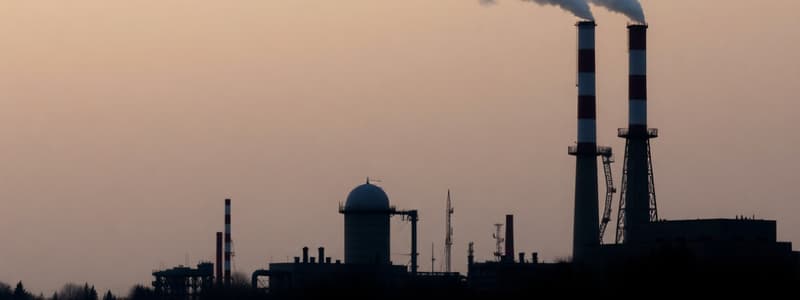Podcast
Questions and Answers
What is a Pigovian tax designed to do?
What is a Pigovian tax designed to do?
- Increase government revenue only
- Subsidize harmful industries
- Correct market inefficiencies (correct)
- Encourage pollution
Negative externalities can only result from production activities.
Negative externalities can only result from production activities.
False (B)
Define marginal cost in the context of market transactions.
Define marginal cost in the context of market transactions.
The cost of producing or consuming one more unit of a good or service.
The _______ principle states that those who pollute should bear the costs of their actions.
The _______ principle states that those who pollute should bear the costs of their actions.
Match the following terms with their definitions:
Match the following terms with their definitions:
What happens to the equilibrium price if negative externalities are not accounted for in the market?
What happens to the equilibrium price if negative externalities are not accounted for in the market?
What is the effect of taxation on external costs in the context of environmental externalities?
What is the effect of taxation on external costs in the context of environmental externalities?
Positive externalities are harmful to society and should be minimized.
Positive externalities are harmful to society and should be minimized.
What is the purpose of a Pigovian tax?
What is the purpose of a Pigovian tax?
The equilibrium price is always synonymous with the highest possible price in a free market.
The equilibrium price is always synonymous with the highest possible price in a free market.
Define price elasticity of demand.
Define price elasticity of demand.
The ______________ principle states that polluters should bear the costs related to the damages they cause.
The ______________ principle states that polluters should bear the costs related to the damages they cause.
Match the following concepts with their definitions:
Match the following concepts with their definitions:
Which of the following best describes optimal pollution?
Which of the following best describes optimal pollution?
What is the role of a price ceiling?
What is the role of a price ceiling?
Welfare economics studies the effects of resource allocation on social welfare.
Welfare economics studies the effects of resource allocation on social welfare.
What does the Free-rider Effect primarily lead to in terms of public goods?
What does the Free-rider Effect primarily lead to in terms of public goods?
The Coase Theorem suggests that property rights directly resolve disputes without costs involved.
The Coase Theorem suggests that property rights directly resolve disputes without costs involved.
What is the Holdout Effect?
What is the Holdout Effect?
The principle that requires the polluter to bear the cost of pollution is known as the ______.
The principle that requires the polluter to bear the cost of pollution is known as the ______.
If a factory is assigned the right to pollute, what is a potential issue that communities may face when trying to compensate the factory?
If a factory is assigned the right to pollute, what is a potential issue that communities may face when trying to compensate the factory?
Assignment of rights to either the factory or the communities guarantees a simple resolution to pollution disputes.
Assignment of rights to either the factory or the communities guarantees a simple resolution to pollution disputes.
Define Marginal Benefit.
Define Marginal Benefit.
Match the following economic concepts with their descriptions:
Match the following economic concepts with their descriptions:
Flashcards are hidden until you start studying
Study Notes
Welfare Analysis of Externalities
- Price ceiling is a government-imposed maximum price for a good or service, usually implemented to protect consumers from high prices.
- Welfare economics studies how resource allocation impacts social welfare.
- Welfare analysis helps evaluate the effects of price ceilings, such as those implemented for natural gas, which aims to benefit consumers.
Optimal Pollution
- Optimal pollution is the level where the cost of reducing pollution (abatement cost) equals the benefit of reducing pollution (improved health and environmental quality).
- Zero pollution is impractical because production inevitably generates some pollution.
- Society must determine an "optimal" pollution level based on the trade-off between production and environmental impact.
The Theory of Environmental Externalities
- Externalities are unintended consequences of market transactions impacting those outside the transaction.
- Negative externalities create harmful impacts, such as pollution, which are not reflected in market prices.
- Positive externalities create beneficial impacts, such as afforestation, benefiting those not involved in the original transaction.
Internalizing Environmental Costs
- Internalizing external costs involves incorporating external costs into market decisions, often through taxation.
- Pigovian tax is a tax levied on activities generating negative externalities to reflect the true social cost.
- Examples of Pigovian taxes include excise taxes on cigarettes and sugar-sweetened beverages.
Property Rights and the Environment
- Coase Theorem states that in the absence of transaction costs, efficient outcomes will emerge regardless of initial property rights allocation.
- Free market environmentalism advocates for property rights and market mechanisms to address environmental issues.
- Free-rider effect occurs when individuals benefit from a resource without contributing to its upkeep, leading to undersupply of public goods.
- Holdout effect occurs when a single entity can obstruct multi-party agreements by making exorbitant demands.
Studying That Suits You
Use AI to generate personalized quizzes and flashcards to suit your learning preferences.




